Sticky Postings
All 242 fabric | rblg updated tags | #fabric|ch #wandering #reading
By fabric | ch
-----
As we continue to lack a decent search engine on this blog and as we don't use a "tag cloud" ... This post could help navigate through the updated content on | rblg (as of 09.2023), via all its tags!
FIND BELOW ALL THE TAGS THAT CAN BE USED TO NAVIGATE IN THE CONTENTS OF | RBLG BLOG:
(to be seen just below if you're navigating on the blog's html pages or here for rss readers)
--
Note that we had to hit the "pause" button on our reblogging activities a while ago (mainly because we ran out of time, but also because we received complaints from a major image stock company about some images that were displayed on | rblg, an activity that we felt was still "fair use" - we've never made any money or advertised on this site).
Nevertheless, we continue to publish from time to time information on the activities of fabric | ch, or content directly related to its work (documentation).
Tuesday, July 11. 2017
Wave Theory of Light, 1802 | #electromagnetics #interferences
Note: some early optic art from 1802?
The visual optics plates were realized by scientist Thomas Young at that time, when he was studying light (wave theory of light). It took another 100 (and fifty) years to truly access the art world...
My question would be: what kind of "plates" are getting drawn today? (and this drives us to Leonardo, to art-sciences programs of different sorts, etc.)
Via Wikipedia
-----
"(...). Nevertheless, in the early-19th century Young put forth a number of theoretical reasons supporting the wave theory of light, and he developed two enduring demonstrations to support this viewpoint.
With the ripple tank he demonstrated the idea of interference in the context of water waves. With the Young's interference experiment, or double-slit experiment, he demonstrated interference in the context of light as a wave. (...)"

Tuesday, June 14. 2016
Breatheable Food | #air #food #particles
Note: the architecture (of atmospheres) could become atomized into fine particles that aggregate in different manners along time, following different "rules" (these "rules" being the ones to be designed by the architect).
While we digg into sensors than monitor elements of the atmosphere (physical and non physical elements), we're definitely looking for a kind of architecture that would "deal" with these elements/particles and recompose them.
Via Cabinet (Spring 2001)
-----
By David Gissen
In the history of architecture and design there have only been a few "effects"—electric light, forced air—that have had the capacity to cause massive environmental and behavioral shifts. Last year at Barcelona's annual design fair, the Catalonian designer Marti Guixe presented another—breathable food. "Pharma-food, a system of nourishment by breathing," is an appliance that was developed by Guixe to explore the transformation of food into pure information.
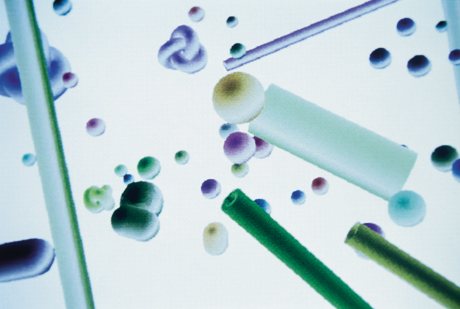
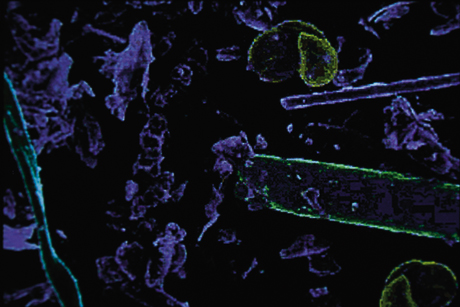
Dust Food Muesli. Photos: Inga Knölke.
Pharma-food joins the work of other, primarily European, designers who are exploring alternative regimens for such activities as washing or eating. One of Guixe's Catalonian contemporaries, Ana Mir, is exploring a technology that allows one to wash without water. Like Guixe's approach, this project would allow washing to occur anywhere. In their work, these designers not only free regimens from their fixed location in relation to certain products; they also free these activities from their traditional engagement with the body. Unlike designers such as Philippe Starck or Richard Sapper, who strive to revise traditional technologies, Guixe has discovered that the problem of eating does not involve the design of a new type of stove, sink, or refrigerator—the problem of eating requires finding a new mouth.
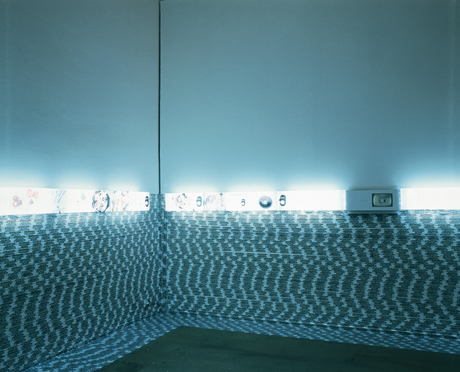
Pharma-BAR. Photo: Inga Knölke.
Guixe, who has been studying alternative forms of eating for several years, realized that the breathing of "food" already occurs via the inhalation of dust that hangs in the air at work and at home. Guixe hypothesized that this form of eating, from which one gains a miniscule amount of minerals and vitamins, could be trans-formed into a more potent meal, a "dust-muesli," that would supply a powerful dose of nutrients. The Pharma-Food appliance, which sprays this ærosolized nutrition, connects to a computer and requires Microsoft Excel to enter exact values for such things as riboflavin, vitamin C, and protein. The combination of these nutrients are saved on the computer as documents with names such as "SPAMT," which has the nutrient "language" of tomatoes and bread, and "Costa Brova," a "seafood" dish that is heavy on the iodine and light on carbohydrates. Guixe imagines diners composing these "meals" and sending them as e-mail attachments to other owners of the Pharma-food emitter. "Like MP3," says Guixe.
While Guixe has explored the experience of eating this information, less explored and of equal significance is where this type of eating can now take place. Guixe imagines Pharma-food in a special "Pharma-bar," essentially a simple room with tables and chairs and several emitters. But why is this necessary when he has liberated food from kitchens and from forms of ingestion that require utensils and dishes? Pharma-food will allow eating to occur anywhere at any time; on subways, in cars, in our beds, while exercising, sleeping, or making love. Most interesting is what effect this device will have on the home, particularly the American home, which is dominated by the kitchen. While technologies are given free range at work and in other public spheres, the home is typically the place where devices such as Pharma-food are tamed and held in balance by a previous technology that the new device is meant to replace. Central heat did not eliminate the fireplace; it allowed this formerly grimy, soot-filled artifact to become an æsthetic symbol and heart of the American home. People began using fireplaces less, but when they did, they burned wood in them again instead of coal. Similarly, cooking the monthly meal may involve stoking a wood-fueled, cast-iron stove while simultaneously breathing a few appetizers with friends.
-
David Gissen is associate curator for architecture and design at the National Building Museum in Washington, D.C. He is currently developing an exhibition on human conveyance (elevators, escalators and moving sidewalks) and one on flying buildings.
Related Links:
Friday, June 14. 2013
Harmony cannot be obvious
Via Domusweb
-----
By Jack Self
Rather than a mere folly, Sou Fujimoto's Serpentine Pavilion is sincere in his proposition about the future of architecture and its place in the world.
If Vivaldi’s Summer is the architectural high-season, then the Serpentine Gallery Pavilion is its opening refrain — a measured, majestic transition from the long British winter to the frenetic hyperactivity and crystalline skies of summer proper.
Perhaps for this reason the Pavilion always attracts a certain sleepy journalism, as though the whole press hadn’t yet had their morning coffee. One reads endless tales recounted as though written in a half-waking state — soggy with dream-like odes and fanciful metaphors, rambling and extravagant, but almost universally uncritical.
On the rare occasion that a pavilion does get bad press, it is invariably childish insults hurled at the architect with a kind of impertinent bad-temperedness: “Nouvel resembles an ageing bouncer,” (Edwin Heathcote, FT) “I smell Jean Nouvel before I see him,” (Tom Dykhoff, The Times) “A one idea building from a once extraordinary architect” (Ellis Woodman, The Telegraph). In fact, although Nouvel’s 2010 shape-shifting red pavilion was received terribly, it remains the only attempt to broaden public engagement beyond the over-priced Fortnum & Mason’s coffee bar. With free kite flying, table tennis, chess and checkers, it became for a short period the only building in all of Knightsbridge that didn’t force you to spend money to enjoy its amenities.

Top and above: Sou Fujimoto, Serpentine Gallery Pavilion, 2013
More importantly, critique of the Serpentine Pavilion as an institutional project is totally absent. Inasmuch as the media accept or reject this or that form, it amounts to whim. We must name the Serpentine Pavilion for what it is: a star factory whose elitist self-perpetuation typifies the vapid iconicity of the pre-Crash years. This is a massive work of architectural branding, or at best, architecture-as-sculpture.
At the core of the whole project is a profound question about the intended benefactor of all these pavilions. For architects, the project’s ambition of providing a platform for little-known practitioners operates like a last-chance saloon for the already established. The category of never having built in the UK only increases the uniqueness of the bijou. For visitors, the pavilions do not serve any obvious purpose beyond to be looked at. Yet most passers-by do not actually spend much time looking at all (about four to six minutes). Presumably many are put off by spaces always focussed around a hopelessly over-staffed bar of well-dressed waiters, patiently expecting you to buy a £3 Americano.
The only entity that really profits from the pavilions is of course the gallery itself. Beyond the empty rhetoric, it is publicity for the sake of publicity.

Sou Fujimoto, Serpentine Gallery Pavilion, 2013
All this is unfortunate really, because Sou Fujimoto’s nebulous pavilion is possibly the finest yet. Rather than a mere folly, Fujimoto is sincere in his proposition about the future of architecture and its place in the world. A polite, quiet, deferential man, he speaks slowly, but explains himself with eloquence and a precise clarity. I quickly notice a pattern in the way he responds to questions: first a tactful and positive remark, then his opinion.
I asked him who the structure was really for, and what was its purpose. He said, “It is for the people of London, and visitors of many different nations, to behave nicely in this park.”
After a pause he added in a lower tone, “Of course, we have some other ideas which are not about today but about the future urban environment. A pavilion of this size should not be concerned with super-practical things, because that can limit its life to the present. It should not be for now, but for 20 or 50 years later. People can imagine how such a living environment could be the future city, or future house, or the future park. I like to create such imaginings, and I hope people just casually enjoy this dream of architecture’s potential.”
He spoke about Corbusier, and how influenced he had been by the Modular. A simple unit based on the body, he said, had great power to harmonise, or integrate, differing scales. Corbusier was also remarkable for how he used small projects to express powerful ideas. Then he spoke about how Toyo Ito’s 2002 pavilion generated a lot of interest in Japan, heightened by SANAA in 2009. I got the impression that for Fujimoto the pavilion represented a platform; a coded message; a statement of intent pointed at his own country (as much as to anywhere, or anyone, else). When I asked if he had plans to build again in Britain he gave me a look of slight bemusement. “I like the UK a lot, and I feel very welcomed here.” The pause. “I do not have any current intentions of building here.” Would you though? “My work for the moment is in Japan.”

Sou Fujimoto, Serpentine Gallery Pavilion, 2013
For an outsider, Japan’s complex social order can be at times impenetrable. Certainly though, something that has always struck me is the traditional continuity between generations of architects — where in the West each younger generation has to forcefully overthrow, reject (even denounce) their elders, the Japanese seem harmonious and respectful.
On the contrary, Kengo Kuma told me recently that just because he goes for Sake and Karaoke with Ito and Sejima (his words), it doesn’t mean he won’t take advantage of any opportunity to distinguish himself and declare his independence. As the youngest Japanese architect to do a pavilion, how did Fujimoto relate to this type of culture, with respect to Ito and SANAA?
“Actually, we have a nice relationship between the generations. I myself didn’t work for Ito-san, or SANAA, but they are very open and generous. They appreciate and elevate the young. They like to know what’s next, and what is the younger energy. That’s really great. We get such nice support.” Pause. “At the same time, we discuss architecture.”

Sou Fujimoto, Serpentine Gallery Pavilion, 2013
I asked if that made it difficult to disagree? “We don’t have to just say yes. Sometimes we propose our opinion or objections, and that makes the relationship founded on mutual trust. If you just say yes all the time, it means that in a different condition you might say no, and that damages trust. We can enjoy these types of talks. They’re not fights. I am now 41, and the younger generation is coming up, and some of them are quite talented. So we have a responsibility to those who are younger, to support them and encourage them, just as I have seen Ito-san, or Sejima-san’s attitude to make the whole atmosphere of architecture in Japan more energetic, and more active.”
As you manoeuvre around the pavilion the form changes quite radically, and in a sense it is quite hard to say what shape it is. Normally, the architectural press (and Serpentine Gallery) don’t like shapeless pavilions, as though each building must be reducible to its own 32-pixel icon. Unlike Nouvel, the response to Fujimoto has been overwhelmingly positive, which led me to think there might be different kinds of formlessness.

Sou Fujimoto, Serpentine Gallery Pavilion, 2013
“I agree. I personally saw Nouvel’s pavilion,” says Fujimoto. “From far away, it was a red square on a green background; it was quite beautiful. Inside, you couldn’t easily understand the form, or how the structure worked, or how the spaces were made. It was just red, and then less red, and then more red... I really like such an approach to architecture, that doesn’t focus on the form of the object, but on the qualities of the subjective experience, and I was fascinated by that.”
He continues. “For me, it was important to produce a structure that definitely had a shape, but one that was ambiguous. If you are outside the pavilion, this shape should be blurry. From different directions you should have completely different impressions. If you are inside, the object should disappear, it should be a gradient of shifting densities and transparencies. From some directions it is more like a floating cloud, and then from others more of a forest, or a group of trees. These are harmonious qualities, but they must be approached very carefully, it cannot be too strong. Harmony cannot be obvious.” Jack Self (@jack_self)

Sou Fujimoto, Serpentine Gallery Pavilion, 2013
Related Links:
Friday, October 22. 2010
Dangers in the Air: Aerosol Architecture and Invisible Landscapes
-----

In late 2009, researchers at the Mayo Clinic in Rochester, Minnesota, validated some horrifying claims: 24 slaughterhouse workers from two states had reported symptoms ranging from numbness to paralysis. What all the claims had in common was the workers' location at or near the “head table” in pork processing plants where pig heads are butchered. Investigations revealed that the workers had inhaled a mist of pig brains, and that this had in turn triggered an auto-immune response, causing neurological disorders. This was not only disgusting; it was also a surprise to scientists to learn that “aerosolized” pig brains, the microscopic industrial byproduct of mechanically blowing out every last piece of flesh from a pig's head, can impair the motor functions of anyone who breathes them in.
Perhaps it shouldn't have been a surprise. Almost a century ago, the air we breathe was first understood to be, potentially, a weapon — an innovation that was, like so many innovations, born in warfare, and which marked a turning point for the modern mind. So argues German philosopher Peter Sloterdijk in Terror from the Air, his exploration of the rise of environmental warfare, starting with the German army's deployment of chlorine gas against French and Canadian soldiers at the battle of Ypres in 1915. [1] With the invention of poison gas, the air itself — the imperceptible atmosphere that surrounds us — could be activated, differentiated and unleashed as a killer — as a kind of anti-air. It could be weaponized, and as such used against civilian as well as military populations, a latent concern that became newly pressing in the post-Sept. 11 autumn of 2001 when somebody, most likely a scientist in an American army lab, sent packets of anthrax spores though the U.S. mail, killing five people and infecting seventeen others who breathed in the dust that became airborne when they opened the envelopes.
As architecture theorist Enrique Ramírez has noted, on his site, aggregat456.com, all airborne attacks — he traces a line from the U.S Army's Chemical Warfare Service in Japan during World War II to the 1995 sarin gas attack on the Tokyo subway, attributed to the Aum Shinrikyo cult — take malign advantage of the diffusing properties of the air, and of the workings of our pulmonary systems, which deliver the oxygen our bodies need to live. Indeed, the history of weaponized air is long and sometimes macabre. For the past couple of decades — to cite just one more example — the U.S. military has been contaminating otherwise safely breathable air by shooting uranium-tipped bullets. When fired, the bullets become extremely hot, which enables them to pierce armored tanks. Such bullets have been used on battlefields from Kosovo to Baghdad, and also on bases such as the former practice range at Vieques, Puerto Rico. They leave a barely detectable plume in their wake, polluting the air and exposing local civilians to the dangers of radioactivity.

Air in Art and Architecture
Aerosolized pig brains and various forms of weaponized air suggest we have underestimated the presence of air, and what it can potentially do. Whatever the spur, we need to take seriously the materiality of air. And today, in fact, a growing number of artists and architects are engaging air in new ways. They are exploring air as a design component, studying how airborne particles can be manipulated into various textures, surfaces and spaces. They are transforming the scales at which architects typically work. And they are bringing the multiple temporalities of air into play through designs that actually collect and archive air from different times. This work could bring about a new consciousness and perhaps an expanded understanding of the meaning of a public architecture — an effort to reclaim the air from those who've attempted to control it in irresponsible and dangerous ways.
Some of the designers who have begun this reclamation project use whimsical strategies, experimenting with tints, adhesives, odors, vapors and other airborne media to harness the latent architectural possibilities of our atmosphere. Especially notable is the work of the Madrid architect Nerea Calvillo, who refers to urban air as “invisible layers that also are landscapes,” and who has worked with a multidisciplinary team to investigate and reveal the hidden or less apparent geographies of cities. Calvillo's project, In the Air, aims “to make visible the microscopic and invisible agents of Madrid’s air (gases, particles, pollen, diseases, etc.), to see how they perform, react and interact with the rest of the city.” To do this Calvillo and her team mixed bright, organic paint tints with water vapors and released them into Madrid’s air; in effect, they have made a mechanical prototype of an atmosphere, which they call a “diffuse façade.” Calvillo's goals, as the project develops, are to explore how these diffuse facades might operate as an index revealing the particulate content of the air, and more broadly, to render the atmosphere visible to the city's residents. Calvillo's "invisible layers" or "diffuse facades" might also be integrated into the actual facades of buildings, in this way "blurring architecture with atmosphere." [2]
There are, of course, potential hazards with this sort of visualization. It might become confusing, a mass of undecipherable information that a viewer can’t easily sort through. It might also become merely an aesthetic spectacle — a razzle-dazzle data performance sans political meaning or artistic depth. And no matter the goals of the designers, information that unexpectedly becomes visible can be politically suspect — unclear in its motives and methods. Its persuasive capabilities can be elusive as well as treacherous. But Calvillo hopes to empower public health activists who seek to verify or disprove air quality claims made by interests ranging from the state to corporations.

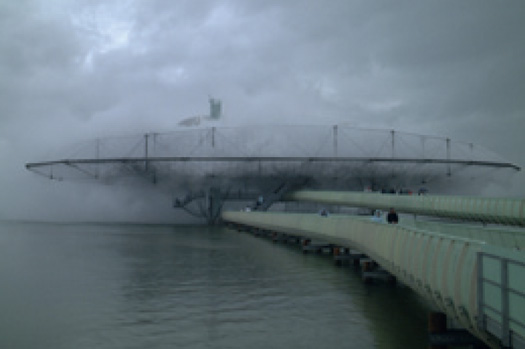
When viewed formally, as architectural spaces of uncertain shape, Calvillo's clouds are part of a contemporary trend, and bring to mind other architectural experiments, most famously the Blur Building, created by Diller Scofidio + Renfro for the Swiss Expo 2002. That project, an "architecture of atmosphere," in the designers' term, challenged the materiality and permanence of conventional construction, using a misting-nozzle "smart weather" system that responded to changing atmospheric conditions. Although, like most expo projects, the Blur was a temporary structure, it worked largely in the tradition of the architecture project of a certain scale, and its atmospheric element — its blur — is conceived and experienced as a monolithic unit, in contrast to the “invisible layers” of Calvillo's In the Air.
Another building conceptualized as a response to its atmospheric environment is the B_mu, a museum project in Bangkok, by the Paris-based architecture practice R&Sie(n). Never built, the radical project, which has achieved a kind of cult status, consists of a stack of rectilinear gallery spaces wrapped in a drooping shroud coated with an electromagnetic material that would attract particles from the polluted city air, much the way the screen of a computer monitor attracts dust. The project drew inspiration from Man Ray’s 1920 Dust Breeding (Duchamp’s Large Glass with Dust Notes), a long-exposure photograph of dust collecting on Duchamp's The Large Glass. As envisioned by the architects, the museum would, with time, become fuzzy and sooty. In this sense R&Sie(n) wanted to harvest the air itself. Yet much like the Blur Building, the project remains conventional in program, organization and scale — and even the social meaning of the pollution itself remains unclear and thus unchallenged. Cocooned in the climate-controlled museum, visitors would have been literally protected — and politically distanced — from the complex networks of relations that enabled the pollution in the first place.
New Airscapes
Given the social provocations of In the Air, even recent projects like Blur and B_mu seem increasingly to belong to an early generation of air design that replicated customary scales of architectural work. Calvillo’s work opens up something new, something that might eventually allow users to “make” new atmospheres based on diverse personal or group agendas. Her sights are set on transforming the smallest pieces of architectural form, what she calls "the microscopic agents that are with us" — spaces that we are often unaware of, but which are everywhere.
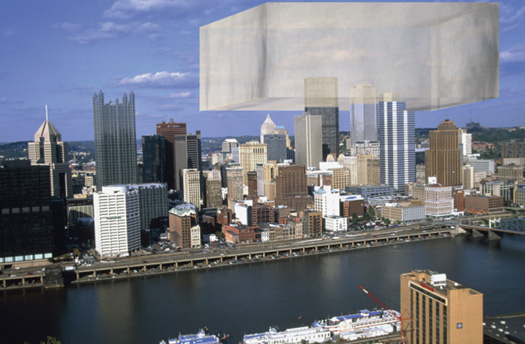
Architectural historian David Gissen has written powerfully about the challenge of how to use and to avoid one type of air: smoke. In his book Subnature and on his website, Gissen has speculated about what it might mean to reconstruct the soot-filled air that once dirtied industrial cities like Chicago and Pittsburgh. The goal would not be to re-pollute the city but to create a kind of archive of the older, smoky air, as a way to better understand the industrialization that once defined the experience of living and working in those cities. Gissen has no illusions of actually implementing this proposal. Rather, he wants to critique the increasingly bourgeois, sanitizing goals of the historic preservation movement, and the type and scale of building often chosen for preservation; and he wants to reveal how the presence — or absence — of smoke in the environment can indicate "social rank and the level of command one has over his or her environment." [3]
Another experimentalist historian, the architect Jorge Otero-Pailos, is focusing on historical preservation at a smaller, more domestic scale. Along these lines, he has proposed recreating the smells of cologne and tobacco that once filled the air of the now landmarked Glass House, by Philip Johnson, in New Canaan, Connecticut. Here too, the idea is to make us think about the atmosphere of the place when it was a salon crowded with architects and artists — and smokers — like Mies van der Rohe and Andy Warhol, cluttered with ashtrays and hazy with smoke.
Gissen and Otero-Pailos’s speculations resonate with Calvillo's work, and especially with one of her observations about air: Calvillo has pointed out that when we occupy a space we are inevitably experiencing its accumulated atmosphere. We are inhaling air in the moment, but we are also inhaling air that has lingered, sometimes for a long time. (This becomes especially apparent in sealed-off spaces like basements and attics.) Thus In the Air extrapolates a dreamy urbanism, where atmospheric layers become a kind of mosaic, a perceptible vision, and one moves through fogs of various colors, or even of different smells and perhaps of inebriants that might mentally transport us, as the madeleine transported Proust, to other places or times. (On a related note, Bompas & Parr, architect-producers of what we might call à la carte happenings, concocted a cloud of breathable gin-and-tonics for a London gallery opening in April of 2009.)
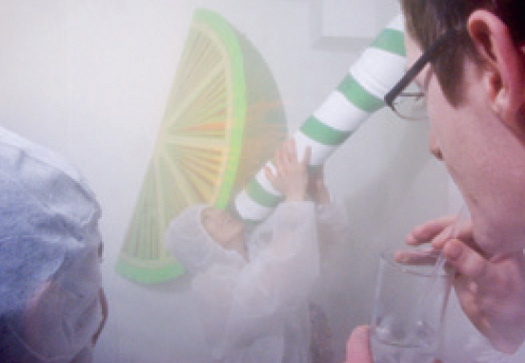
The designers of In the Air, on their detailed website, imagine a future when we might all participate in atmospheric creation: "A domestic version of the prototype will be developed. Assembly instructions will be posted on the web and each user will be able to make a unit for their balconies or windows. This will generate a distributed net of visualizations, representing the data collected throughout the city. An individual can “tune” their unit to select the pollutant they are interested in tracking — this will allow for the construction of a collective map of personal environmental interests."
These days we read many claims and assertions about ecology and clean air. What if, as In the Air suggests, we could suspend a plume of tinted air created from years-old data and evaluate it next to a plume created from current data? Has the air improved, or not? Is the particle density greater or lesser? Using In the Air's instruction manual, perhaps one could sift out the air made by a certain polluter, and even re-situate it or blow it into a different location — perhaps toward the polluter’s corporate offices. One could colorize the pollutants that hover over a landscape we are forbidden to enter, like the base at Vieques, with its uranium cloud, so that local residents could identify it from afar. (The base has been demobilized as a “wilderness refuge” — a U.S. government tactic for avoiding the remediation entailed by Superfund designation.) These actions could take air into the realm of political contestation, activating streets and public spaces. But all of this will only be possible when we no longer perceive air as monolithic, singular and static.
In Subnature, Gissen notes that architectural theory and history offer fleeting glimpses of the problem of vapors and dirty air, usually in discussions of chimneys, vents, and other building technologies meant to exhaust smoke from spaces while at the same time retaining the heat and the social pleasure of a hearth fire. Smoke or pollution that contaminates homes, workplaces or entire cities has sometimes signified urban dysfunction or lack of progress, or conversely, modernity and industrialization. Today we are exploring ever more technologically advanced techniques for carbon capture and sequestering, and for using toxic residue like fly ash to make concrete for roads and buildings. Certainly these techniques serve to minimize harmful emissions; they also perhaps reinforce our tendency toward "out of sight, out of mind." In comparison, the projects envisioned by Calvillo, Gissen, Otero-Pailos and others have the opposite aim: to make bad or questionable air visible, part of our perceptible experience, and in this way to make it a real part of our political discussion.
fabric | rblg
This blog is the survey website of fabric | ch - studio for architecture, interaction and research.
We curate and reblog articles, researches, writings, exhibitions and projects that we notice and find interesting during our everyday practice and readings.
Most articles concern the intertwined fields of architecture, territory, art, interaction design, thinking and science. From time to time, we also publish documentation about our own work and research, immersed among these related resources and inspirations.
This website is used by fabric | ch as archive, references and resources. It is shared with all those interested in the same topics as we are, in the hope that they will also find valuable references and content in it.
Quicksearch
Categories
Calendar
|
|
July '25 | |||||
| Mon | Tue | Wed | Thu | Fri | Sat | Sun |
| 1 | 2 | 3 | 4 | 5 | 6 | |
| 7 | 8 | 9 | 10 | 11 | 12 | 13 |
| 14 | 15 | 16 | 17 | 18 | 19 | 20 |
| 21 | 22 | 23 | 24 | 25 | 26 | 27 |
| 28 | 29 | 30 | 31 | |||
